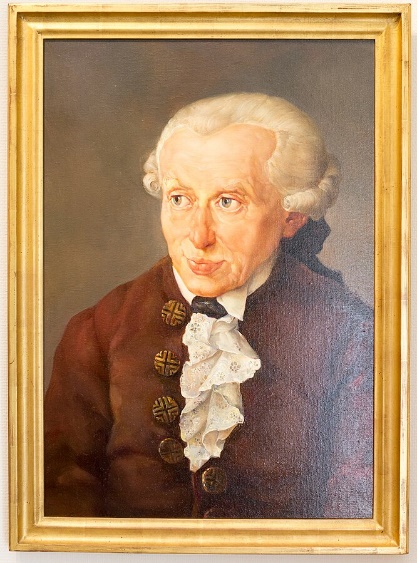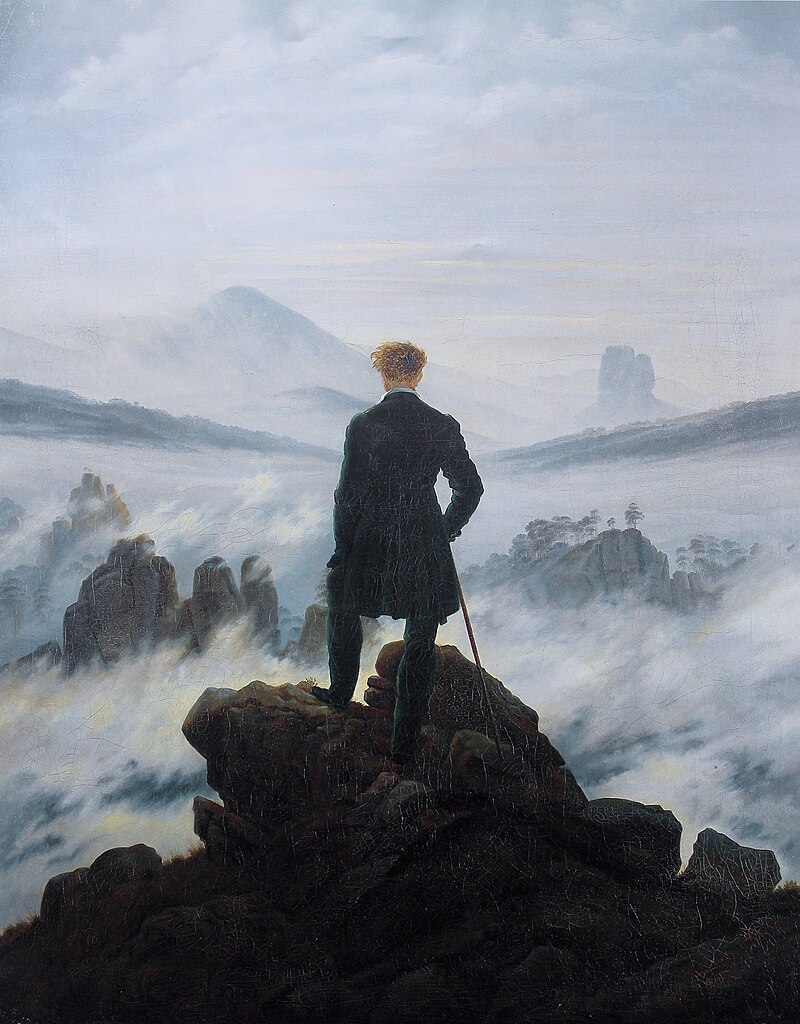9.4 Is Beauty Objective or Is It Only a Matter of Preference? – Kant
LEARNING OBJECTIVES
By the end of this section you will discover:
- How Immanuel Kant argued that our judgments about beauty are not a matter of individual or social opinion but an objective reality within the mind.
- How his analytic of the beautiful sought to articulate and verify the different components of our experience of beauty.
- How his analytic of the sublime sought to define the highest forms of aesthetic appreciation.
As we saw in the previous section, it’s certainly possible to have disagreements over the creativity of a particular piece of art, a song, a play or movie. You might have wondered how friends could look at artworks so differently. Perhaps to avoid argument you “agreed to disagree” or settled on the adage “to each their own.” But does this really address the issue of the work’s aesthetic value? Isn’t there some way to decide whose opinion is closer to the truth? Or is beauty merely “in the eye of the beholder,” as the old saying goes? Shouldn’t it be possible to find objective standards for our appreciation of beauty that allow us all to understand what constitutes the beautiful and what does not?
One of the most important works in the history of aesthetics is Immanuel Kant’s Critique of Aesthetic Judgment (1790). Kant, like Hume, lived in an age of Neo-Classical arts.

Recall that Kant had agreed with the empiricists’ assessment that knowledge begins with experience, that we are not born with innate standards of truth or beauty but had disagreed with the skepticism implied by their subjectivism. In his Critique of Pure Reason he had argued that our empirical knowledge from experience must conform to pre-existing conceptual structures in the mind—the twelve categories of the understanding, like space, time, and causality, through which we interpret experience. [See section 4.2.4 above]. In his Critique of Practical Reason he had examined the possibility of deriving ethical and moral knowledge or justification using “practical” reason—i.e.: our capacity for rational deliberation and reasoning that leads to action–without basing morality on empirical considerations alone. He claimed that practical reason can motivate our moral will effectively through an absolute moral imperative or command, the categorical imperative. [See section 3.4.2 above].
In applying pure reason to the human appreciation of art in his Critique of Aesthetic Judgment (1790) Kant attempts to seek a basis for an objective, universal sense of beauty that does not rely solely on experience or opinion. Kant felt no need to rely upon Hume’s Ideal Critics to establish the objective nature of aesthetic judgments. Instead, he sets forth an analytic of the beautiful in which he defends the objectivity of our experience of nature, what he calls judgments of free beauty.
Judgments of free beauty refers to our subjective experience of beauty when we perceive an object or artwork. These are judgments when we find an object beautiful for its own sake, without needing to relate it to anything external or compare it to another object. We appreciate its beauty just by contemplating the object itself. Kant said these kinds of pure, disinterested judgments of beauty are subjective and universal – they rely only on our internal experience of the beautiful object and we expect others to agree with our judgment. These judgments are considered “free” because they are not based on any particular concept or predetermined rules. Instead, they arise from our immediate aesthetic pleasure or feeling of delight upon perceiving something beautiful. According to Kant, we know something is beautiful if it meets the following criteria: it is 1) subjective, 2) disinterested, 3) universal, 4) necessary, and 5)
…a singular judgement concerning the contemplative pleasure that everyone ought to derive from the free play (and the quickening) of the faculties of the imagination and the understanding in relation to (and in response to) forms of finality (forms of purposiveness, or purposiveness without a purpose).
This requires unpacking.
By the free play of the faculties of imagination and understanding Kant suggests that pleasure emerges when our experience of beauty is not tethered to concepts or purposes but is instead “free” to discover patterns in nature devoid of cognitive intent. Recall when you were young you would lie in the grass with friends and look for images in the clouds? It seems the mind is uncomfortable with randomness and seeks patterns. Kant argued the mind is equally active when engaged with works of art. When we experience something beautiful, our faculty of imagination, which usually provides intuitive representations to the understanding, is awakened on its own in a purposeless, free, and indeterminate way. In addition, the faculty of understanding (which normally applies rules/concepts to the imagination) responds equally freely to the creativity of imagination by playing along with imaginative activity in an indeterminate yet harmonious manner. So both faculties engage in uncontrolled, spontaneous free play that is self-reinforcing back and forth (imagination awakens understanding, which encourages more imaginative activity, and so on).
By forms of finality Kant means that the patterns we discover in the beauty of nature suggest that they are a product of intentionality or design “without our knowing…what it has been designed for.” When we observe natural phenomena like flowers, crystals, organic life forms etc., their orderly arrangement seems to display unity, regularity, harmony, and purposive form aimed at a specific function or end. Yet Kant argues this “formal finality” is only a product of our cognitive faculties – imagination and understanding – reflecting upon natural structures and projecting purpose/design where there may be none in reality. We represent natural forms “as if” they were intrinsically purposeful or crafted to meet goals, though no actual conscious intention guides them. This is an inevitable function of human cognition seeking comprehensible order and meaning. Still, this appearance of objects embodying formal finality triggers an aesthetic response in us – we get pleasure from contemplating natural forms exhibiting seemingly intentional systematicity and purposiveness, though no designer exists.
In addition to judgments of free beauty, Kant says one may also make judgements of dependent beauty. Unlike our aesthetic appreciation of the patterns in nature, dependent beauty is the beauty found in a particular human-made object or presentation, an instance of an excellence in kind. Such presentations, unlike free beauty, possess the intentionality or purposiveness of the artist. They depend on conceptual knowledge required to appraise, distinguish, or pick out the salient features of the object being judged aesthetically. The judgment of dependent beauty is conditioned on knowing the purpose, function, objectives, or meaning of the object via determinate concepts. For example, finding a particular building (like a church or palace) beautiful relies on knowing the building’s purpose and assessing if its form matches its designated function successfully. The aesthetic response therefore arises by comparing features of the object against conceptual knowledge of what the object should be, do, mean, or accomplish. It presupposes identified purpose. Kant contrasts this with pure judgments of beauty that are completely independent of concepts, semantics, interpretation, background theories, or an object’s rationally understood functionality. For example, finding a flower beautiful because its appearance simply strikes us as attractive and harmonious rather than applying any logical concepts or analyzing its uses/functions. Works of art may possess both forms of beauty, the natural/unpurposive and the intentional.

Finally, Kant introduces the analytic of the sublime. The sublime is, for Kant, a category of aesthetic experience that cannot be subsumed in his prior notions of beauty because it contains a necessary element of displeasure. He distinguishes two concepts of the sublime: the mathematical and the dynamic. The mathematical sublime is to be found in our response to the infinite or the enormous. Such encounters make us awestruck at the power of our reason to contemplate such vastness. The dynamic sublime can be found in our encounter with the ferocity of nature when we realize that there is something in us that nature cannot touch. In his conclusion to the Critique of Practical Reason he had famously stated:
Two things fill the mind with ever new and increasing admiration and awe, the more often and steadily we reflect upon them: the starry heavens above me and the moral law within me. I do not seek or conjecture either of them as if they were veiled obscurities or extravagances beyond the horizon of my vision; I see them before me and connect them immediately with the consciousness of my existence. (Critique of Practical Reason)
In such admiration Kant seems to be encountering the sublime.
Our judgments of sublimity bring us into what Kant calls our vocation of reason, the call to go beyond (transcend) the limitations of the imagination and sensory experience. For Kant, the “vocation” or calling of reason refers to reason’s destined purpose of establishing unified knowledge, guiding moral action, and facilitating comprehensive understanding at various levels. The aesthetic experience of the sublime pushes us toward an integration of all our reasoning–Pure Reason, Practical Reason, Judgment–toward an absolute totality in knowledge. Though we can never achieve this, the ideal of a perfectly unified system regulating human cognition and action underlies reason’s calling. In general, Kant believed our rational faculty feels destined to pursue integration, self-coherence, universality, and ultimacy across our thought and knowledge. Its vocation is to harmonize human mental powers through an ideal rational system. The aesthetic sense is a catalyst toward this unification.
So for Kant, art fulfills a deeply human need to represent values and meanings beyond the physical experience, ultimately serving to ground us morally. By pursuing free beauty, art indirectly shows that being virtuous and acting from duty, as ends in themselves, have worth. Its ultimate purpose is thus profoundly moral – to cultivate, reflect and indirectly represent moral life through the aesthetic manifestation of universal ideas and feelings it evokes. Beauty symbolically suggests that nature accords with the highest principles of human freedom.
Works Cited
Immanuel Kant (1724-1804) https://commons.m.wikimedia.org/wiki/File:Wustrau_Brandenburg-Preu%C3%9Fen_Museum_Immanuel_Kant_%281724-1804%29-3944.jpg, CC BY-SA 4.0. Accessed 11 Mar. 2024.
Caspar David Friedrich, Wanderer above the Sea of Fog (1818), https://en.wikipedia.org/wiki/German_art#Baroque,_Rococo_and_Neoclassicism. Public Domain. Accessed 11 Mar. 2024.

